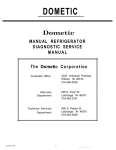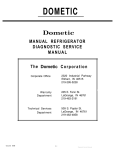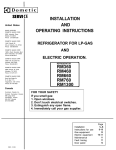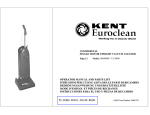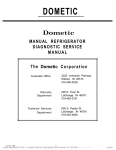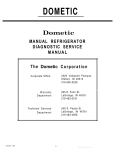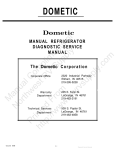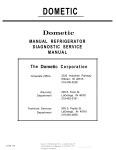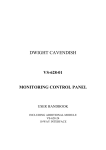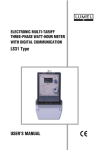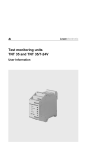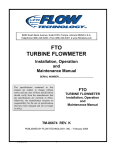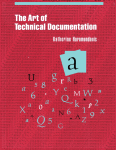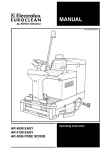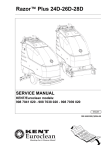Download RM360 RM460 RM660 RM760 Service Manual
Transcript
etic 1 1 United States SALES OFFICES DOMETIC SALES CORP. 2320 Industrial Pkwy. Elkhart, IN 46515 Phone 219-295-5228 DOMETIC SALES CORP. 14441 Bonelli St. City of industry, CA 91746 Phone 818-968-9431 DOMETIC SALES CORP. 1625-A Rock Mountain Blvd. Stone Mountain, GA 30083 Phone 404-493-6214 DOMETIC SALES CORP. 7895 SW. Hunziker Rd. Portland, OR 97223 Phone 503-620-9510 DOMETIC SALES CORP. 2920 Avenue “E” East Alington, TX 76011 - P h o n e 817-277-72 1 East Oak Ridge Dr. Rt. 9, Box I7 A Hagerstown, MD 21740 Phone 301-797-0826 1000 01 ” DOMETIC SALES CORP. RM360 RM460 RM660 RM760 Canada Euroclean Canada Inc. Dometic Recreation Division 866 Langs Drive Cambridge, Ontario N3H 2N7 Canada (519) 653-8880 REFRIGERATOR , SERVICE MANUAL -1 Edition RM360 RM460 RM660 RM760 1 Publication No. 5415-E I Service DSC #650 Diagnostic Service Manuals 2 Installation page 3 Instructions for use page 6 Cabinet adjustments page 8 To change door panel page 8 Panel dimensions page 8 Replacement of door gasket page 9 Reversing outer door page 9 Replacement of evaporator door on RM360/460/660 page 9 Replacement of evaporator door gasket on RM360/460/660 page 10 The absorption cooling unit page 10 Operation analysis for cooling unit page 10 Cooling unit replacement RM360/460/660 page 11 Cooling unit replacement RM760 page 12 The gas/electric equipment page 13 Replacement of gas/electric equipment complete page 14 Disassembly of gas/electric equipment page 14 Disassembly of burner jet and burner page 15 Operation analysis for LP gas refrigerators - p a g e 15 Operation analysis for refrigerators operating on electricity page 16 Wiring diagrams page 17-18 3 INSTALLATION ELECTRICAL GENERAL 115 Volts A C INSTRUCTIONS The refrigerators outlined hereon have been design certified under ANS Z 21.19 Refrigerators by the American Gas Association for installation in a mobile home or recreational vehicle and are approved by the Canadian Gas Association. The certifications are, however, contingent on the installation being made in accordance with the following instructions. CONNECTION The refrigerator is equipped with a three prong (grounded) plug for protection against shock hazard and should be plugged directly into a properly grounded three prong receptacle. Do not cut or remove the grounding prong from this plug. The cord should be routed to avoid coming in contact with the burner cover, flue cover or other hot components. The installation must in the USA conform with: 12 Volts VDC optional for certain models 1. National Fuel Gas Code Z223.1-1974 2. Mobile Homes A119.1-1972 3. Recreational Vehicles A119.2-1970 4. Any applicable local code On "Tri-Pover" units there is an additional terminal block marked "12 V". The refrigerator must be connected to the battery circuit with two wires of adequate capacity to avoid voltage drop. The wire gage should be chosen with consideration to the wire length in accordance with the following tabel: The 12 V circuit must be fused with an appropriate fuse. In Canada TABLE 1. Standard CGA lO.l/CSA 2240.4 gas equipped mobile housing and recreational vehicles 2. Standard CSA Z240.6.1 electrical requirements for mobile housing 3. Standard CSA Z240.6.2/C22.2 No 148 electrical requirements for recreational vehicles Maximum two conductor wire length for different AWG numbers. The unit must be electrically grounded in accordance with the National Electrical Code ANSI, CI1968, when installed if an external alternating current electrical source is utilized. Maximum two conductor wire length in feet AWG RM360 120w RM460 135w RM660 175w RM760 250W 14 12 10 8 6 4 10 17 27 43 69 110 9 15 25 40 64 102 7 12 19 31 49 79 5 8 13 22 34 55 Ventilation The installation shall be made in such a manner as to separate the combustion system from the living space of the mobile home or recreational vehicle. Openings for air supply or for venting of combustion products shall have a minimum dimension of not less than l/4 inch. Proper installation requires one lower fresh air intake and one upper exhaust vent. The ventilation kits shown in this instruction booklet have been certified for use with the refrigerator models listed in the tables. The ventilation kits must be installed and used without modification. An opening towards the outside at floor level in the refrigerator compartment must be provided for ventilation of heavier-than-air fuel gases. The lower vent of the recommended kits is provided with proper size opening. For ready serviceability of the burner and control manifold parts of the refrigerator the lower side vent is fitted with a lift-out panel which provides an adequate access opening. Do not use the body or chassis of the vehicle as a substitute for either of the two conductors. No other electrical equipment or lighting should be connected to the refrigerator circuit. The refrigerator will draw from l0-21 Amps at 12 Volt depending on model. CAUTION Do not operate the refrigerator on 12 Volt when the vehicle is parked. You will run out of battery in a rather short time. GAS CONNECTION Hook-up to the gas supply line is accomplished at the manual gas valve, which is furnished with a 3/8" SAE (UNF 5/8"-18) male flare connection. All completed connections should be checked for leaks with soapy water. The gas supply system must incorporate a pressure regulator to maintain a supply pressure of not more than 11 inches water gage. F i g . 1 m 4 If possible the installation of a 12 Volt operated refrigerator should be completed with a relay mounted either in the car or in the recreational vehicle (see Fig. 1). This relay will automatically cut out the refrigerator when the car motor is stopped. SPECIAL HINTS The refrigerator must be installed in a substantial enclosure and must be level. A spirit level is supplied with each refrigerator and by placing it in the freezer compartment one can level the refrigerator both ways front to back and side to side. When installing the refrigerator in the enclosure care should be taken to ensure a complete sealing between the front frame of the refrigerator and the top, sides and bottom of the enclosure. For this purpose a length of sealing strip is applied to the rear surfaces of the front frame. A sealing strip should also be applied to the foremost floor of the enclosure as shown in Fig. 2. / l-l _. Be careful not to damage the sealing strip applied to the floor of the enclosure when the refrigerator must be blocked. The heat produced at the rear of the refrigerator will otherwise become trapped in this space making the top of the refrigerator hot and reducing the efficiency of the refrigerator. Minimum w ventilation height CERTIFIED INSTALLATION Certified installations require one roof vent and one lower side vent or as optional one upper vent and one lower side vent. The two alternatives are provided for by using the different kits listed in the Appendix. For further information contact your dealer or distributor. Fig.3 METHODS OF INSTALLATION The methods of installation are shown in figures 3 and 4. It is essential that all maximum or minimum dimensions are strictly maintained as the performance of the refrigerator is dependent on an adequate flow of air over the rear of the refrigerator. area 5"x 18” Ventilation VENTILATION HEIGHTS Refrigerator RM360 RM460 RM660 RM760 :.jiiGj Minimum ventilation heights in inches 37 31 34 42 56 5 CLEARANCES Minimum clearances in inches to combustible materials are: G: K: L: M: Top Side Bottom Rear 0 0 0 1 Clearance M between the rear-most part of the refrigerator and the wall behind the refrigerator. Clearance N on top of the condenser is related to the minimum ventilation height. See Fig. 5 and examples below. Fig.5 MEASUREMENTS Height A RM360 RM460 RM660 RM760 Recess dimensions Installation dimensions Refrigerator Overall dimensions model Width B Depth C Height h 21 11/16 6 22 1/16 29 9/16 30 3/8 24 11/16 6 32 1/8 32 15/16 6 23 24 11/16 6 40 40 13/16 6 23 23 24 11/16 51 3/16 52 Width W 20 21 21 21 Distance between top of condenser to top of refrigerator 1/4 9/16 9/16 9/16 Depth d Height Width W H 20 22 22 22 29 32 40 51 3/16 6 3/4 3/4 3/4 3/4 5/16 6 3/16 6 3/8 20 21 21 21 1/2 13/16 6 13/16 6 13/16 6 Storane volumes Refrigerator Total storage volume in cu ft model RM360 RM460 RM660 RM760 3.0 3.9 5.1 6.0 EXAMPLES The clearance N for the RM360 model is derived atin the following way: A. Installation with upper and lower side vents. N=Minimum ventilation height 37 minus installation height 29 9/16 plus distance between condenser top and refrigerator top 1 l/4 N=37-29 9/16+1 l/4=8 11/16. B. Installation with roof vent and lower side vent. N=Minimum ventilation height 31 minus installation height 29 9/16 plus distance between condenser top and refrigerator top 1 l/4 plus distance between roof surface and roof vent cap 5 l/4. N=31-29 9/16+1 l/4+5 l/4=7 15/16. Fig.6 Depth D 21 23 23 23 3/16 3/4 3/4 3/4 e 1 1/4 1 1/4 1 1/4 1/8 6 INSTRUCTIONS FOR USE INSTALLATION OF THE REFRIGERATOR IN A VEHICLE The refrigerator must be installed on a solid floor and must be level. With the vehicle carefully leveled the refrigerator should level both ways in the freezer compartment. Free air circulation over the fins of the cooling unit is essential. Clearances around the refrigerator should be in accordance with the label attached to the rear plate of the refrigerator. In case detailed instructions on the installation and connection to the gas supply are required, contact your dealer or distributor. Leveling In the boiler ammonia vapor is distilled from an ammonia-water mixture and carried to the finned condenser, where it liquifies. The liquid flows to the evaporator, where it creates cold by evaporating into a circulating flow of hydrogen gas. If the evaporator coil is not level the liquid readily accumulates, forming pockets w h i c h can impair the gas circulation or even block it, in which case, of course, the cooling will stop. When the recreational vehicle is stationary it must be leveled to be comfortable to live in. If the refrigerator is properly installed, i e the freezer shelf parallel to the floor, the refrigerator will then also perform well. A bubble level should be placed on the freezer shelf. When the vehicle is on tow, the continuous rolling and pitching movement will not affect the refrigerator as long as the movement passes either side of level, but when the trailer is temporarily parked this sensitivity of the refrigerator should be remembered. So, once more, before you start the refrigerator, make sure it is level. 4. After the gas is lit keep the button C pushed for 10 seconds. Release the button and check through the reflector that the burner flame stays burning. If not repeat the lighting procedure. NOTE: After a replacement of the gas container or a long shut off period the gas line is likely to be filled with air. In such a case the lighting procedure has to be repeated until the air is pushed out of the line and the gas has reached the burner. Flame Blow Out If trouble is encountered with the flame blowing out under specially windy conditions, try to avoid the wind blowing against the wall where vent outlets are located. If the trouble persists, set the thermostat to MAX. This later measure can of course only be temporary such as when the vehicle is on tow, for after a day or so at this setting the foodstuffs in the cabinet will freeze. Electric Operation (Fig. 7) 1. Check that the attachment plug is correctly connected to the mains supply. When the refrigerator is equipped also for 12 Volts D C operation the low voltage connection is made at the marked terminals at the rear of the refrigerator. 2. Turn the knob A to desired position for electric operation. 3. Turn the thermostat knob B to setting 4. HOW TO USE THE REFRIGERATOR Food Storage Compartment HOW TO START THE REFRIGERATOR. The food storage compartment is completely closed and unventilated, which is necessary to maintain the required low temperature for food storage. Consequently foods having a strong odor or liable to absorb odors should be covered. Vegetables, salads etc. should be covered to retain their crispness. The coldest positions in the refrigerators are underneath the cooling evaporator and at the bottom of the refrigerator, and the least cold positions are on the upper door shelves. This should be considered when different types of food are placed in the refrigerator. Frozen Food Storage Compartment Fig.7 Gas Operation(Fig. 7) 1. To start position 2. Turn the 3. Push the D of the repeated This can the refrigerator turn the knob A to "GAS". thermostat knob B to setting 4. button C to stop and push the button piezo igniter. The pushing has to be until the gas is lit at the burner. be observed through the reflector E. The ice trays should be placed in direct contact with the freezer shelf for fastest ice making. Quick frozen soft fruits and ice cream should be placed in the coldest part of the compartment, which is at the bottom of the aluminum liner or, in models with a shelf, on this or just below it. Frozen vegetables, on the other hand, may be stored in any part of the compartment. The compartment is not designed for the deep or quick freezing of foodstuffs. Meat or fish foods, whether raw or prepared, and provided they are precooled in the refrigerator, can however, also 7 be stored in the frozen food storage compartment. They can then be stored about three times as long as in the fresh food storage compartment. To prevent drying out, keep food in covered dishes, in plastic bags or wrapped in aluminum foil. CAUTION Do not store explosive substances in the refrigerator, such as cigarette lighter gas, petrol, ether or the like. of weeks, it should be emptied and cleaned and the door left ajar. The ice trays should also be dried and kept outside the cabinet. Cleaning To clean the interior lining of the refrigerator use lukewarm weak soda solution. The evaporator, ice trays and shelves must, however, be cleaned with warm water only. Never use strong chemicals or abrasives to clean these parts or the protective surface will be spoiled. It is important always to keep the refrigerator clean. Ice Making Periodic maintenance Ice cubes can be made in the ice trays which should be filled with water to within l/4" (5 nun) from the top. To release the ice cubes seize the tray with both hands and twist the tray. Cubes not required should preferably be replaced in the tray. Refill the tray with water and replace the tray on the freezer shelf. Ice making is accelerated if the thermostat knob is turned to setting "MAX". It is a good idea to do this a few hours before an anticipated need for ice but be sure to turn the knob back to normal setting when the ice is formed or the foodstuffs in the cabinet may become frozen hard. Defrosting Some refrigerator models are equipped with an automatic defrosting device incorporated with the cooling unit. This device makes a quick defrost of the finned evaporator section about once a day without affecting the frozen food storage compartment or the frozen foods contained in. When the frozen food storage 'compartment is covered with frost the refrigerator must be shut down temporarily till the frost is melted. Before the refrigerator is restarted the compartment should be dried, the ice trays washed and refilled with fresh water. When the frost on the finned evaporator section has melted, water will be collected in the drip tray. The drip tray should be emptied at regular intervals. Some refrigerators without the automatic defrosting device should be defrosted regularly' by turning off the refrigerator. Empty the refrigerator leaving the drip tray under the finned evaporator and the cabinet and freezer doors open. If desired, defrosting may be speeded up by filling the ice tray with hot water and placing it in the freezer. When all frost is melted, empty the drip tray and dry the interior of the refrigerator with a clean cloth. Replace the drip tray and ice tray, replace all food stuffs and set the thermostat to "MAX" for a few hours. Then reset the thermostat knob to its normal position. To Shut Down the Refrigerator To shut down the refrigerator temporarily set the thermostat to off and turn off the gas tap. If the cabinet is not in operation over a period NOTE: Before working on the refrigerator, make sure that 110 V A. C. and optional 12 VD.C. leads are disconnected. Once or twice a year depending on use, it is necessary to clean and adjust the burner assembly. Proceed as follows: 1. Loosen screw and remove cover plate for burner housing. 2. Disconnect lighter cable from the electrode. 3. Loosen burner fixing screw and withdraw burner. 4. Clean burner tube with a brush. Blow with compressed air. 5. Screw off jet and clean with alcohol. Blow with compressed air. Never use a needle or similar. 6. Clean flue baffle and flue. 7. Clean the cooling unit and the floor under the refrigerator. 8. Reassemble. 9. The entire gas installation should be checked for leaks. Test all pipe connections with soapy water, not with an open flame. a CABINET ADJUSTMENTS To change door panel The refrigerator is normally delivered without door panel(s). Before starting the mounting work check that the panel dimensions are in compliance with those given in the table and read the instructions through. When mounting the panel, proceed as follows: 1. Remove the top decoration strip (2) with its two screws (1). 2. Insert one of the vertical edges of the p anel into the groove of the door frame (3). 3. Bend the panel gently so that the free side of the panel can be slipped into the corresponding groove of the door frame (4). 4. Push the panel downwards so that the lower horizontal edge of the panel is fitted into the bottom groove (5). 5. Between the upper edge of the panel and the door frame there is now a gap which should be covered by the decoration strip. 6. Put the strip across the door so that the gap is covered and push it upwards (6). The tabs on the inside of the strip should fit in behind the flange of the door frame. Secure the decoration strip by means of the two screws (1). Panel dimensions Thickness max. 5/32" Height Min. Width Max. Min. 516,5 20 11/32" 513,5 mm 20 7/32"inch 550,5 21 11/16" 547,5 21 9,16":ch 550,5 21 11/16" 547,5 mm 21 9/16"inch 285 288 11 11/32" 11 7/32" 550,5 21 11/16" 547,5 mm 21 9/16"inch 798 801 31 17/32" 31 13/32" 550,5 21 11/16" 547,5 mm 21 9/16"inch Type Max. RM 360 636 25" RM 460 676 679 26 23/32" 26 19/32" RM 660 879 34 5/8" RM 760 upper RM 760 lower 633 24 7/8" 876 34 l/2" Fig.8 9 Replacement of door gasket (Fig. 9) 1. Pull the old gasket out from the door frame. 2. Make sure that no gasket parts are left in the groove. 3. Beginning in one of the corners, fit the new gasket by pressing it into the groove. Fig.9 Reversing outer door (Fig. 10) 1. Remove the plastic cover (1) by loosening the screws (2) underneath. 2. Remove the upper hinge pin (3). 3. Remove the door and move the lower hinge pin (4) to the other side. 4. Fit the door and press the upper hinge pin (3) into the adequate hole. For two-door refrigerators the middle hinge and the travel latch should change position. Fig.10 Replacement of evaporator door on RM360, RM460, RM660 (Fig. 11 and 12) 1. Pry the spring housings (B) away from the li- ning so that it snaps out and turn the spring housing downwards 180'. 2. Push the carrier (A) inwards by means of a blunt mandrel or pin and remove the shutter. 3. Mount the new shutter in close position first on one side, making sure that the cross slots engage in the cross on the hinge plate (C). 4. Press the carrier on the opposite side so that the hinge plate on the shutter can be pushed over it. See that the crosses engage. 5. Turn the spring housing round and up until the small tag (D) snaps into the slot into the lining. Fig.11 Fig.12 Replacement of evaporator door gasket on RM360, RM460, RM660 1. Remove the door as previously described. 2. Unscrew the hinge plates (A fig. 13). 3. Put shutter on a flat surface with the sealing gasket up. 4. Pry the shutter front away from the inner pan by means of a screwdriver. CAUTION: It is of great importance that the screw driwer is applied in front of one of the plastic tongues (B fig. 13) which hold the inner panel and the shutter front together. 5. Replace the sealing gasket round the inner panel and snap the inner panel with sealing gasket into the shutter front until the tongues snap in position. 6. Mount the shutter as described above. Fig.13 THE ABSORPTION COOLING UNIT Sealed system construction The sealed system of the absorption refrigerator is constructed of welded steel piping which contains the refrigerant charge. The charge consists of ammonia, hydrogen and water. There are no moving parts associated with the absorption system. If an excessive vaporizing of the ammonia within the boiler occurs due to the reasons above, the liquid mixture in the boiler becomes very weak and the pump will cease to operate, which means that the circulation of liquid stops with the result that the evaporator inside the cabinet ceases to produce cooling. When servicing an absorption system refrigerator, do not puncture or break the piping. Should a break occur and ammonia contact the skin, wash the affected area immediately with clear water. Do not attempt to open the valve on the absorber vessel. The valve is covered with a plastic can and should never be removed. Such a blockage of the unit in the liquid circuit ist most usually made evident by signs of overheating on the vapour pipe leading from the boiler to the condenser, the paint on this pipe being blistered and the metal becoming discouloured. OPERATION ANALYSIS FOR COOLING UNIT It is obviously important that all external factors affecting the unit should be checked properly before a unit is condemned as faulty and that emphasis has been placed upon the necessity for correct installation, upright refrigerator, correct heat input, baffle position, etc. Check the size and the wattage of the electric heater and make sure that the heater element is inserted to its full length in its pocket. If the electric heater is only partly inserted, the heat distribution will be incorrect, causing an excessive vaporizing of the ammonia within the boiler when operating on electricity. The same symptom can show up with too much or too little heat input either on electric or on gas operation and also if the refrigerator had been operating in an off-level position or with inadequate ventilation. To remedy this fault it is recommended to remove the unit or refrigerator complete whenever possible and to allow sufficient time to- cool down the unit. Turn the unit or refrigerator upside down several times, so that the liquid in the absorber vessel can be mixed with the liquid in the boiler. This procedure will restore the liquid balance to the unit. The temperatures on various parts of a unit vary continuously when it is operating on thermostatic control and it is impossible to base a judgment on the symptoms given unless the refrigerator has been operating continuously on fully correct heat input for at least 5 hours, and preferably 12 hours, prior to examination. In many cases this can be arranged by a telephone call to the customer, asking him to switch the thermostat to "MAX" on the day before the inspection call. If after 12 hours' operation on "MAX" the performance is satisfactory, the unit is not at fault unless the complaint is one of varying or intermittent performance. In this connection 11 the room temperature at the time of the complaint must be considered, as a unit which is satisfactory at an ambient temperature ofo650F (+18OC) may not be satisfactory at 95 F (+35 C). In cases where satisfactory performance is obtained "MAX" but not on other settings, the thermostat is to be suspected. When a normal unit is working on "MAX" the absorber coil will be warmer at the bottom than it is at the top. The absorber vessel will be warmer. The vapour cooling pipe from the boiler to the condenser will be warm, bearably to the hand, at the bend where it joins the condenser, with a gradual rise in temperature towards the boiler end. Unit filling valve The needle valve used for admitting the filling charge to a cooling unit is fitted to the unit's absorber vessel and is covered by an aluminium or plastic cap. It is strictly applied provision of the warranty extended on the unit to the customer, that any interference with the filling valve will automatically void the warranty. Unsatisfactory unit performance due to an ammonia leak can be determined in the case of a visible leak by traces of a yellow deposit at the point where the ammonia is escaping. If there is a leak on the evaporator inside the cabinet, a smell of ammonia may bee noticeable. COOLING UNIT REPLACEMENT RM360, RM460, RM660 Remove the refrigerator from its recess as follows 1. Check that refrigerator is empty and remove ice tray. 2. Turn off gas bottle. 3. Disconnect gas line to inlet valve CAUTION: Use a backup wrench to prevent undue rotation. 4. Unplug the electric line from the trailer outlet. 5. Remove the 4 screws in rear front frame. 6. Check for any additional screws which the vehicle manufacturer may have used to fasten the refrigerator in place. 7. Carefully slide the refrigerator straight out of its recess. Fig.14 - 6 To remove the cooling unit from the cabinet, proceed as follows: 1. Place the refrigerator on a work bench of suitable height. 2. Remove the thermostat capillary tube by loosening the two screws (1) on the evaporator fins (fig. 14). CAUTION: The locations of the thermostat capillary tube should be noted at this time for relocation later on. The tubes must be placed in the right position, otherwise, improper performance may result. 3. Remove the two sealing plugs for capillary tube, one on the back and one inside the cabinet, and straighten the tubes. 4. Remove the capillary tubes by going to the back of the refrigerator and gently pulling the tubes straight out. Fig.15 12 5. Remove the screws (2) in fig. 14 and take away the evaporator fin. Remove the screws (3). 6. Remove the connection block (4) cover (Fig. 15) and disconnect the electrical wires for the heaters. 7. Remove the grounding screw (5).(Fig. 15). 8. Remove the flue and the flue baffle. 9. Remove the screws (6), holding the absorption unit onto the back of the cabinet. 10. Disconnect the burner case by turning the lever (7) as shown in the picture. 11. Carefully bend absorption unit out of cabinet (Use a crowbar or similar and a wooden piece as protection when doing this). 12. To replace absorption unit, reverse above procedure. 8 9 CAUTION: 1. Be sure to apply sealing permagum (8) on the unit mounting plate (Fig. 16). 2. Be sure to apply proper amount of "Thermal Mastic" on the evaporator coil (9). 3. When fitting the evaporator fin be sure to tighten the screws properly in order to obtain a perfect contact between the evaporator coil and evaporator flange, otherwise improper cabinet performance may result. Fig.16 Fig.17 COOLING UNIT REPLACEMENT RM760 The following steps are different from the models RM360, RM460 and RM660. 1. The screws (1) in the freezer should be removed (Fig. 18) 2. The capillary tube should carefully be pulled out from the tube (2).(Fig. 19). 3. When bending the cooling unit out, place the crowbar or similar as well as the wooden protection as shown in the picture. Fig.18 Fig.19 13 THE GAS/ELECTRIC EQUIPMENT Fig.20 Gas equipment parts 1. 2. 3. 4. 5. 6. 7. 8. 9. 10. 11. 12. 13. Burner tube Burner, housing Jet Feeler point thermocouple) Flame failure safety device Bypass screw Gas/Electric thermostat Pressure test gage connection Capillary tube for thermostat Shut-off value Piezo igniter Firing tip Flue baffle Electric equipment parts 14. 15. 16. 17. 18. 19. Flexible cord Change-over switch Terminal block, 12 VDC Fuse Relay Heater 14 Replacement of gas/electric equipment complete 1. Remove the covers by removing the screws (1). 2. Disconnect the heater cords at the terminal blocks (note the locations for later relocation). 3. Remove the capillary tube carefully from the evaporator. 4. Remove the screws (2). 5. Release the burner housing from the flue by turning the lever (3) as shown. 6. Pull the equipment out from the cabinet. 1. 1 115v 220v 240v _12V ZI Fig.21 Disassembly of gas electric/equipment 1. Press the plastic latch (leftwards in Fig. 22). 8. Press the retaining spring for release of thermocouple. 2. Pull the relay out (if any). 9. Pull out the thermocouple leftwards. 3. Snap off the fuse holder. 4. Press the spring. 5. Pull the shut-off valve out. 6. Press the gas/electric thermostat leftwards and lift it out. 7. Unscrew the thermocouple from the flame failure safety device. 2 0 10. Pull the flame failure safety device left and lift it out. 11. Pull off the ignition cord. 12. Snap off the retaining spring. 13. Pull out the igniter. NOTE: - When assembling, always use new for the joints. Fig.22 O-rings 15 DISASSEMBLY OF BURNER JET AND BURNER removing the screw (1). 1. Remove the cover by 2. Unscrew the 3. Remove the burner by removing the screw (3) burner jet (2). OPERATION ANALYSIS FOR LP GAS REFRIGERATORS S Y M P T O M CAUSE P z : 48 u 2:: 2 c .rl c .z : ‘;: S ;: 8” ” c .; l.l MZ T1z 8 8 8 c) 5 z * 0) ‘d 2 g j $ .j : L 2 .rl&W .rlz g MW 4.l z u ti ‘;: ‘C : ;: : : z ?” diz$LZ80a x Note: It will be noted in this tabulation that several causes can be responsible for the one effect. The real cause or causes should be determined by a process of elimination, investigation each possible cause. proceeding to the bottom. Fig.24 Gas leaks 16 OPERATION ANALYSIS FOR REFRIGERATORS OPERATING ON ELECTRICITY r S Y M P- T-O M- C A U S E 272 2 5 20 Note: It will be noted in this tabulation that a 4-l rl 5 2 G .rl 0”u 4-l“d .di ! *rlls -G” w z g 2u .d4 zlL! z .rls % “d E 5cc G 2&J .dt.4 .?I u ‘;1 it v-4 ICI 8 0’ ” 0 0 d d 2 x X - X X - X - - -X X X - - - -X - -X -X X X - -X -X -X - - -X -X - - - - X - - -X -X - -X -X -X - - -iz - X X - X - -0” -X -X -X - several causes can be responsible for the one effect. The real cause or causes should be determined by a process of elimination, investigating each possible cause, starting at the top of the tabulation and proceeding to the bottom. Not adequate ventilation Refrigerating unit not level Heater faulty,wrong voltage or type Voltage not constant Electric connections loose Heater not inserted correctly in its pocket Improper food storage The thermostat incorrectly used Improper storage of liquids and moist foods Leaky cabinet seals Infrequent cleaning of food compartment Refrigerator shut off with closed door Unwrapped odorous food Incomplete contact of thermostat capillary tube Lost thermostat charge Failed refrigerating unit Room temperature too low 17 12VOLTS DC 200 7 3 9 0 12VOLTS DC N L 115 VOLTS AC THERMOS TAT 0 JUNCTION BLOCK 0 TERMINAL BLOCK @ GREEN @ GREEN/YELLOW Fig.25 Wiring Diagram for Product No. 926 63 01 RM760 115VOLTS A C Fig.26 Wiring Diagram for Product No. 926 63 02 RM760 18 20075871 115VOLTS A C @ SWITCH @I THERMOS TAT 8 JHEyTIRm B L O C K @ WHITE @ BLACK @ GREEN Fig.27 W i r i n g D i a g r a m f o r Product No. 926 69 01, 926 70 01, 926 71 01 RM360 RM460 RM660 -I 115 VOLTS AC m @ SWITCH @I T H E R M O S T A T 0 JUNCTION BLOCK @ HEATER e> TERMINAL BLOCK 8 FUSE @ HEATER - - N_ l Lr-7 I 8, 6 BLACK @j GREEN @ GREEN/YEL LO W Fig.28 I zzz Wiring Diagram for Product NO. 92 6 02, 92 7 02, 926 71 02 RM360 RM460 RM660



















